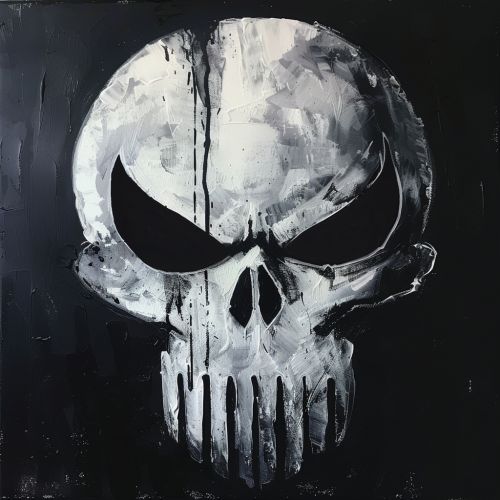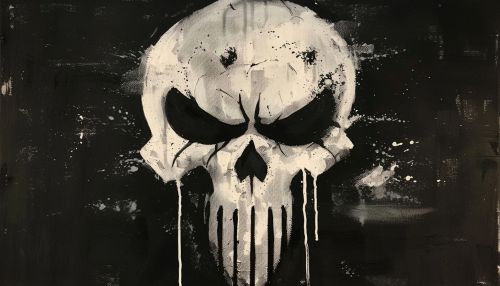The Punisher
Overview
The Punisher is a fictional character appearing in American comic books published by Marvel Comics. Created by writer Gerry Conway and artists John Romita Sr. and Ross Andru, the character made his first appearance in The Amazing Spider-Man #129 (cover-dated February 1974). The Punisher is a vigilante who employs murder, kidnapping, extortion, coercion, threats of violence, and torture in his campaign against crime. Driven by the deaths of his wife and two children, who were killed by the mob for accidentally observing a mob hit, the Punisher wages a one-man war on the underworld using various weapons.
Character Development
The Punisher, whose real name is Frank Castle (born Francis Castiglione), is a former Marine who saw his family gunned down for accidentally observing a mob hit. Consumed by rage and grief, Castle declared a one-man war on crime, utilizing his military training and a vast array of weaponry. Unlike most superheroes, the Punisher has no superpowers and relies on his military training, guerrilla warfare tactics, and an extensive arsenal of firearms and explosives.
Early Appearances
The character was initially introduced as an antagonist for Spider-Man, but his popularity led to a series of solo stories. The Punisher's early appearances were marked by his brutal methods and a moral code that was in stark contrast to the more traditional superheroes of the time. His willingness to kill criminals set him apart and made him a controversial figure within the Marvel Universe.
Evolution Over Time
Over the years, the Punisher has evolved from a one-dimensional vigilante into a complex character with a rich backstory. Writers have explored his psychological state, delving into the trauma that drives him and the ethical implications of his actions. The character has been depicted in various ways, from a ruthless killer to a tragic anti-hero, reflecting changing societal attitudes towards justice and retribution.
Abilities and Equipment
The Punisher is a highly trained soldier with expertise in hand-to-hand combat, guerrilla warfare, and marksmanship. His military background provides him with skills in strategy, tactics, and survival. He is proficient with a wide range of weapons, including handguns, rifles, explosives, and knives.
Weapons and Gadgets
The Punisher's arsenal is vast and varied, including conventional firearms, explosives, and specialized equipment. He often uses body armor and advanced surveillance gear to track and eliminate his targets. His iconic skull emblem, painted on his chest, serves both as a psychological weapon and a form of body armor.


Vehicles
The Punisher employs various vehicles in his war on crime, including customized vans and motorcycles equipped with weaponry and surveillance technology. These vehicles are often heavily armored and modified to suit his needs in combat situations.
Psychological Profile
Frank Castle's transformation into the Punisher is driven by a deep-seated need for vengeance and justice. His psychological profile reveals a man consumed by anger and grief, struggling with post-traumatic stress disorder (PTSD) and survivor's guilt. His relentless pursuit of criminals is both a coping mechanism and a form of self-punishment.
Moral Ambiguity
The Punisher operates in a moral gray area, often blurring the lines between hero and villain. His methods are extreme, and his willingness to kill sets him apart from other vigilantes. This moral ambiguity makes him a complex and controversial figure, raising questions about the nature of justice and the ethics of vigilantism.
Impact and Legacy
The Punisher has had a significant impact on popular culture, influencing various forms of media, including comic books, television series, and films. His character has been portrayed by several actors, each bringing their own interpretation to the role.
In Comics
The Punisher has appeared in numerous comic book series, both as a solo character and in crossover events with other Marvel superheroes. His stories often explore themes of vengeance, justice, and the consequences of violence. Notable story arcs include "Welcome Back, Frank," "The Slavers," and "War Journal."
In Television and Film
The Punisher has been adapted into several live-action films and television series. Notable portrayals include Dolph Lundgren in the 1989 film, Thomas Jane in the 2004 film, Ray Stevenson in the 2008 film, and Jon Bernthal in the Netflix series "Marvel's The Punisher." Each adaptation has offered a different take on the character, reflecting the evolving nature of his story.
Cultural Significance
The Punisher's popularity has made him a cultural icon, representing the darker side of the superhero genre. His character challenges traditional notions of heroism and explores the complexities of justice and retribution. The skull emblem has become a symbol of rebellion and anti-establishment sentiment, often used in various forms of media and merchandise.
Controversies
The Punisher's violent methods and moral ambiguity have sparked debates about the ethics of vigilantism and the portrayal of violence in media. Critics argue that his actions glorify violence and undermine the rule of law, while supporters view him as a necessary force for justice in a corrupt world.
